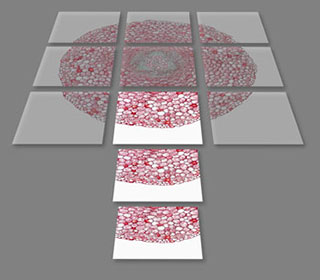
The Process of Making
Microbotanicals
The process of constructing a photo-micrographic image can be painstaking. Magnified images projected by the microscope directly onto my camera’s sensor show only partial views of my tiny slide-mounted botanical specimens. In order to create an image of the entire subject I must capture a series of photographs of overlapping segments that encompass the whole specimen and then stitch them together using a software program that seamlessly unifies them. And, because of a microscope’s extremely shallow depth of field, there is an additional level of complexity: for each of the overlapping segments I must adjust the microscope focus in tiny stepwise increments to capture a stack of identically composed photographs, each having subtle differences in the areas that are in focus. I use yet another software program to combine the most focused areas of each photograph in the stack into a single, well-focused photographic image. Each final image, made up of hundreds or sometimes thousands of meticulously captured photographs, has the detail necessary for making large format prints.
PRINTS
When I began work on Microbotanicals I was studying lithographic printmaking. The visual quality of the handmade prints influenced me to present these photographs on a matte paper, giving them the feel of lithographic prints, or watercolor paintings. All prints are produced in limited editions and exact sizes can be custom ordered. Aspect ratio information is shown with each image. I recommend seeing these prints in person at my exhibitions or through private showings, as the images viewed on the computer do not fully convey the quality and feel of the final prints.
| A simplified schematic |
 |
| Many images required photographing grids of more than 10x10 overlapping photographs with each image stacked 10-12 deep. |
| Return to View Images |